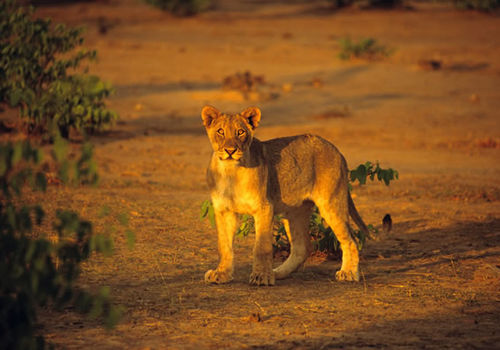
Lion
Panthera leoLion
Introduction: There can be no other species whose distributional range has decreased as much as the lion (Panthera leo). Many are shot, trapped or poisoned when trespassing on farms, or die when their prey ratios are reduced by drought or disease. Lions are great wanderers and spend much of their time hunting, patrolling territories, playing and sleeping. Although they live in prides of up to thirty, comprising between 4 and 12 related females, it is the lionesses that remain in the pride for life. The males form coalitions, defending their female from rival males.
Lions are territorial animals and can defend a territory of up to 400km². Between 2 and 3 years old, young male lions leave the pride and become nomadic for around two years. At the age of five, male lions settle down with their own pride. Females do the majority of the hunting, as a team.
Apart from roaring, lions also communicate by scent-marking their surroundings and even by their facial expressions and body postures. Lions show aggression by showing their impressive canine teeth, flattening their ears and displaying the dark patch behind the ears, their tails twitching in irritation.
Distribution: Lions can only be found in the north of Namibia. Between 250 and 750 lions live in Etosha National Park while smaller populations exist in the Caprivi, Bushmanland and in Kaokoland. Lions have recently returned to the Skeleton Coast Park.
Diet: Lions feed on a wide range of mammals from mice to buffalo, birds up to the size of ostrich as well as reptiles and even insects. Attacks and kills on wildebeest, gemsbok and zebras are common and they are also known on occasion to tackle young elephants and hippo. Their food requirements depend on species available.
Colouring: The lions coat is ideal for hiding. It is a brownish yellow, the same colour as dead grass, another camouflage extra. Their underparts are whitish with a general tawny to sandy tinge. Rosettes and spots are characteristic of young animals and females often retain these on their underparts. Only males have a long tawny mane on the sides of the face and on top of the head. In some individuals, this mane can be much darker, especially in the black-maned lion of the Botswana's Central Kalahari Game Reserve.
Breeding: Lions are non-seasonal breeders, yet females of a pride often synchronize births. After a gestation period of 110 days, 1 to 4 cubs are born and start taking meat after ten weeks. Females suckle their own and one another's cubs for up to 6 months. After birth, cubs are hidden for six weeks after which mothers bring them to the pride's crèche. The young remain dependent on the organizational success of the pride for up to 3 years.
Size: The lion is the largest of the African carnivores and a male usually weighs from 160 to 180kgs, but some weigh up to 230kgs. Most males are about 3m long from nose to tail and are 1.1m tall at the shoulder. Lionesses are smaller and weigh 110 - 140 kg and are about 30cms shorter.
Klein Windhoek

